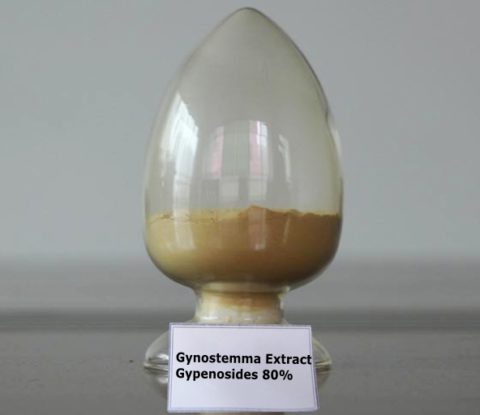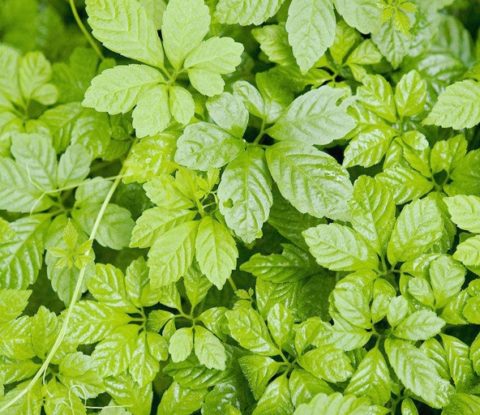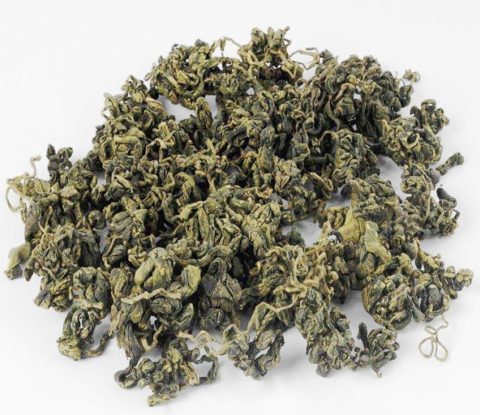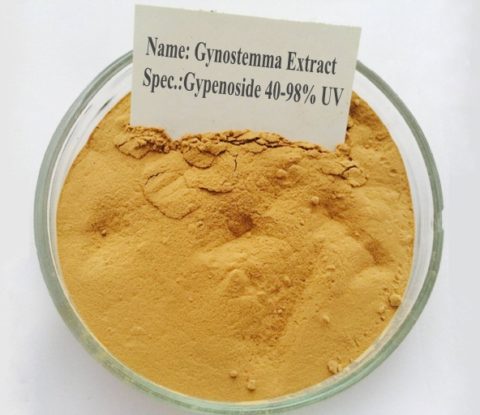
Gynostemma Extract
Gynostemma Pentaphyllum Extract Powder
【Latin name】: Gynostemmatis Pentaphylli
【Other names】: Jiaogulan, Jiao gu lan , Penta tea , Amachazuru (Japan) , Southern ginseng , Dungkulcha (Korea)
【Part used】: Stem&Leaves
【Active Ingredients】: Gypenoside
【Specification】: 40% 80% 90% 98% Gypenoside, 10:1, 20:1
【Test Method】: UV/TLC
【Molecule Formula】: C27H42O3
【Molecular Weight】:1791.83
【Appearance】: Brownish yellow powder
【Particle size】: 95% pass 80 mesh
Brief Introduction
Gynostemma Pentaphyllum is a plant which is sometimes referred to as either ‘Southern Ginseng’ or ‘Cheap Ginseng’ as it was used as a cheap substitute for Panax ginseng (as aside from Codonopsis pilosula, which was used as an adulterant for Panax Ginseng to sell it at the normal price but cut costs). Surprisingly, Gynostemma has a good content of Ginsenosides that were once thought to be wholly unique to Panax Ginseng. As such, the biological effects of Gynostemma and Panax seem to be quite similar except Gynostemma may be more anti-diabetic (due to the unique Gypenosides in Gynostemma, that are not in Panax).
There are limited human studies at the moment, as most studies are attempting to delineate the large amount of Gypenosides in this herb to see which ones can be seen as the ‘active’ compounds. Currently, we have two human studies suggesting that a tea made from Gynostemma can be used alongside standard anti-diabetic therapy and augment the efficacy of it over time.
Most of its ‘beneficial’ effects beyond the diabetic effects (which are mediated by a possible mix of AMPK activation and PTP1B inhibition; the amount each contributes to the overall effects unknown) come from inducing antioxidant enzymes and protecting cells from oxidative damage over time. There seems to be a motif where preloading and chronic loading is very protective at low doses, and acute supplementation or rehabilitation appears to be less effective. As such, the health effects of Gynostemma Pentaphyllum appear to be more prophylactic rather than rehabilitative or therapeutic.
This herb is also touted for youthfulness and longevity, but neither claim has been explored. Additionally, the anti-cance-r effects are still in beginning stages of research but the effects appear to be very similar in many cell lines; some compound in the Gypenoside fragment may be an inducer of p53, a t-umor suppressor gene, as the downstream events associated with p53 activity have been noted repeatedly (although direct kinetics between Gypenosides and p53 have not yet been investigated; this is a likely theory but not established).
Overall, this is a more anti-diabetic Panax ginseng; the downside is that the other benefits associated with Panax Ginseng (adaptogenic, cognitive enhancing, anti-fatigue) have not yet been assessed properly with Gynostemma Pentaphyllum.
Chemical Analysis
The main Gypenoside class of bioactives (those unique to Gynostemma Pentaphyllum) include:
-Gylongiposide
-Gypensapogenin A-D gypensapogenin E-G
-Gypenbiosides A and B
-Gypenosides GC1 to GC7 (2α,3β,12β,20(S)-dammarane type structure)
-Gypenoside III at 0.9% dry weight (a glycoside of Ginsenoside Rb1), IV (a glycoside of Ginsenoside Rb3), VIII at 0.4% (Ginsenoside Rd), XII (Ginsenoside F2)
-Malonyl Gypenosides III and VIII (Malonyl Ginsenosides Rb1 and Rd, respectively)
-Gypenoside LXXIV (G74), Gypenoside XLIX, and Gypenoside A (XLIII)
-Gymnemaside VI
-Gynostemosides A-E (Megastigmane compounds based on the backbone of 3,4-dihydroxy-5,6-dihydro-β-ionol)
-Gynoside A, ocotillone type triterpenoid ((20S,24S)-20,24-epoxy-12,25-dihydroxy-dammaran-3-yl-O-β-D-glucopyranosyl(1→2)-β-D-xylopyranoside) as well as B-E
-Phanoside, a term used to refer to four isomers of a Gypenosapogenin glycoside
Gypenosides are Gypenosapogenin or Ginsenoside structures (the former pictured below) attached to sugars; as such, they are Gypenosapogenin or Ginsenoside Glycosides (Glycoside merely being a term to refer to ‘attached to sugar(s)’; a storage form of sorts).
Indications in TCM(Traditional Chinese Medicine)
Although jiaogulan grows in many Asian countries, there does not seem to be any early historical documentation in existence other than in China. Jiaogulan is pronounced “jow-goo-lan”. Gynostemma pentaphyllum is known as Jiaogulan in China. The plant was first described in 1406 CE by Zhu Xiao, who presented a description and sketch in the book Materia Medica for Famine as a survival food rather than a medicinal herb.4 The earliest record of jiaogulan’s use as a drug comes from herbalist Li Shi-Zhen’s book Compendium of Meteria Medica published in 1578, identifying jiaogulan for treating various ailments such as hematuria, edema in the pharynx and neck, tumors, and trauma. While Li Shi-Zhen had confused jiaogulan with an analogous herb Wulianmei, in 1848 Wu Qi-Jun rectified this confusion in Textual Investigation of Herbal Plants, which also added more information on medicinal usage.
Jiaogulan’s traditional use has not been widespread in China. It was used as a folk herb in the local areas where it grew wild. Jiaogulan grows mostly in the mountainous regions of southern China, far from the central part of China, an area which has long been known as the “ancient domain of China”. This central area of China is where the classical system that we call traditional Chinese medicine (TCM) evolved. For this reason, jiaogulan is not included in the standard pharmacopoeia of the TCM system, and therefore has not had as widespread use as TCM herbs. However, an experienced TCM practitioner in China has analyzed jiaogulan and described its qualities in terms of traditional Chinese medicine, as “sweet, slightly bitter, neutral, warm, enhancing ‘Yin’ and supporting ‘Yang’”, and suggested that “it would be used to increase the resistance to infection and for anti-inflammation.” Jiaogulan has been used by the people in the mountainous regions of Southern China as an energizing agent. They would take it as a tea before work to increase endurance and strength, and after work to relieve fatigue. It has also been taken for general health and has been recognized as a rejuvenating elixir. People also used it for treating common colds and other infectious diseases.
Pharmacological Actions
1. Immunomodulation
Water-soluble polysaccharide from Gynostemma pentaphyllum herb tea (PSGP) was isolated by hot-water extraction and ethanol precipitation. The chemical components and preliminary immunomodulating activity of PSGP were investigated both in vitro and in vivo. Capillary zone electrophoresis analysis showed that PSGP was a typical nonstarch heteropolysaccharide, with glucose being the main component monosaccharide (23.2%), followed by galactose (18.9%), arabinose (10.5%), rhamnose (7.7%), galacturonic acid (4.7%), xylose (3.9%), mannose (3.1%), and glucuronic acid (1.2%). PSGP could significantly stimulate peritoneal macrophages to release nitric oxide, reactive oxygen species, and t-umor necrosis factor-alpha in a dose-dependent manner. This immunostimulating activity of PSGP was further demonstrated by its inhibition on the proliferation of human colon carcinoma HT-29 and SW-116 cells incubated with the supernatant of PSGP-stimulated macrophage culture. It is evident that PSGP is a very important ingredient responsible for at least in part the immunomodulating activity of G. pentaphyllum herb tea.
Their previous report demonstrated that the oral administration of short-term high dose Gynostemma pentaphyllum extract (5 g/kg per day for 7days) decreased allergic reactions in ovalbumin (OVA)-sensitized mice. The aim of this study was to determine whether long-term oral administration of G. pentaphyllum attenuated airway inflammation in OVA-sensitized mice. Mice were sensitized and challenged with normal saline or OVA. OVA-sensitized mice were fed with 1.75 g/kg (low dose, GPL) or 5 g/kg (high dose, GPH) G. pentaphyllum extract, five days a week for 4 weeks. The airway hyperresponsiveness (AHR) and eosinophilia in bronchoalveolar lavage fluid (BALF) were examined. The cytokine levels or antibodies in BALF, serum and spleen cell culture supernatants were also determined. Both high and low dose extracts reduced AHR, serum OVA-IgE, and Th2-associated cytokine levels in spleen cell supernatants and BALF in OVAsensitized mice. These results show that long-term orally administered G. pentaphyllum extract reduced allergic reactions in OVA-sensitized mice.
The specimen of the total saponin for this experimental study was extracted from Gynostemma pentaphylla growing in Suining county in Hunan province. Weight of immune organs, content of anti-SRBC hemolysin, rate of special Ea-RFC formation and percentage of NK cell activity had been employed for the study as experimental indices, both the normal healthy mice and the mice with immunity impairment due to Cyclophosphamide (Cy) management as experimental models. The results of the study exhibited: (1) The total saponin of Gynostemma pentaphylla could markedly act against the immunity inhibition due to Cy management in the experimental animals, showing a variant recovery in mice treated by Cy in weight of the immune organs, content of hemolysin, forming rate of EaRFC and unequivocally elevating NK cell activity, by significant difference in comparison with the Cy control groups (P less than 0.05-0.01). (2) The total saponin showed a definite of bidirective immunomodulatory action in normal healthy mice, recovering the immune indices to normal value from either originally lower or higher than the medium figure, by significant difference in comparison with the Cy control groups (P less than 0.05-0.01). (3) The total saponin had actions to prevent from fatigue and to tolerate hypoxia under usual atmospheric pressure. The above description indicates that the total saponin of Gynostemma pentaphylla is a better immunomodulator, seems to be like the actions of some Chinese drugs, for example, Panax ginseng, Astragalus membranaceus etc.
2. Adaptogenic activity
The action of gypenosides (GP, saponins of Gynostemma pentaphyllum, a Chinese medicinal herb) as an antioxidant was studied using various models of oxidant stress in phagocytes, liver microsomes and vascular endothelial cells. The results show that GP decreased superoxide anion and hydrogen peroxide content in human neutrophils and diminished chemiluminescent oxidative burst triggered by zymosan in human monocytes and murine macrophages. An increase of lipid peroxidation induced by Fe2+/cysteine, ascorbate/NADPH or hydrogen peroxide in liver microsomes and vascular endothelial cells was inhibited by GP. It was also found that GP protected biomembranes from oxidative injury by reversing the decreased membrane fluidity of liver microsomes and mitochondria, increasing mitochondrial enzyme activity in vascular endothelial cells and decreasing intracellular lactate dehydrogenase leakage from these cells. The extensive antioxidant effect of GP may be valuable to the prevention and treatment of various diseases such as atherosclerosis, liver disease and inflammation.
3. Cardio and cerebrovascular effects
Blood pressure- The adaptogenic nature of gypenosides have been found lower hypertension and raise hypotension, keeping blood pressure in a normal range. Laboratory tests demonstrate that jiaogulan stimulates the release of nitric oxide, causing blood vessels to relax; this is one proposed mechanism by which jiaogulan reduces high blood pressure. In a double-blind study, gypenosides administered to with Grade II hypertension showed 82% effectiveness in reducing hypertension, compared to 46% for ginseng and 93% for Indapamide (a hypertension medication). Cardiovascular functions: Animal studies as well as clinical testing on humans suggest that jiaogulan, when combined with other herbs, has beneficial effects on cardiovascular system, increasing heart stroke volume, coronary flow, and cardiac output while reducing the heart rate, without affecting arterial pressure.
The hot water extract of Gynostemma pentaphyllum was found to activate platelet aggregation. However, the active principle was not elucidated. Gypenosides inhibited platelet aggregation in another study. In rabbits, crude gypenosides decreased heart rate, increased stroke volume, dilated blood vessels, and reduced blood pressure while slightly increasing cardiac output. Purified gypenosides 5 and 10 were found to lower systolic and diastolic blood pressure, decrease coronary, brain, and peripheral blood vessel resistance, raise coronary flow, and lower heart rate in dogs. Crude gypenosides protected against cerebral ischemic damage in a rabbit model.
4. Antidiabetes activity
Gynostemma pentaphyllum tea has been used in a Randomized Controlled Trial to treat type 2 diabetic patients. It has shown potential as a hypoglycemic treatment to reduce blood glucose. Extracts from Gynostemma pentaphyllum Makino (Cucurbitaceae), a Southeast Asian herb, has been reported to affect numerous activities resulting in antitumo-r, cholesterol-lowering, immunopotentiating, antioxidant, and hypoglycemic effects. We have isolated one active compound by ethanol extraction, distribution in nbutyl alcohol/water, solid phase extraction/separation, and several rounds of reverse phase high pressure liquid chromatography. We have shown by NMR and mass spectrometry that this active compound is a novel saponin, a gypenoside, which we have named phanoside (21- ,23-epoxy-,3β-,20-,21-trihydroxydammar-24-ene- 3-O-(α-d-rhamnopyranosyl(1→2).-β-dglycopyranosyl(1→3).-β-d-lyxopyranoside)), with a molecular mass of 914.5 Da. Phanoside is a dammarane-type saponin, and four stereoisomers differing in configurations at positions 21 and 23 were identified, each of which were found to stimulate insulin release from isolated rat pancreatic islets. We have also found that the stereoisomers are interconvertible. Dose-dependent insulin-releasing activities at 3.3 and 16.7 mm glucose levels were determined for the racemic mixture containing all four stereoisomers. Phanoside at 500 μm stimulates insulin release in vitro 10-fold at 3.3 mm glucose and potentiates the release almost 4-fold at 16.7 mm glucose. At these glucose levels, 2 μm glibenclamide stimulates insulin release only 2-fold. Interestingly, β-cell sensitivity to phanoside is higher at 16.7 mm than at 3.3 mm glucose, although insulin responses were significantly increased by phanoside below 125 μm only at high glucose levels. Also when given orally to rats, phanoside (40 and 80 mg/ml) improved glucose tolerance and enhanced plasma insulin levels at hyperglycemia.
The aim of the study was to investigate the antidiabetic effect of the traditional Vietnamese herb Gynostemma pentaphyllum in 24 drug-naïve type 2 diabetic patients. All patients were randomized to authenticated Gynostemma pentaphyllum tea or placebo tea, 6 g daily, during twelve weeks and received information regarding diet and exercise. Fasting plasma glucose, insulin levels, and glycosylated hemoglobin (HbA(1C)) were measured before, during, and after the treatment. Oral glucose tolerance tests were performed every four weeks. After 12-week treatment, fasting plasma glucose levels totally decreased to an extent of 3.0+/-1.8 mmol/l in the Gynostemma pentaphyllum tea group as compared to a decrease of 0.6+/-2.2 mmol/l in the control group (p<0.01). HbA(1C) levels after 12 weeks decreased approximately 2% units in the Gynostemma pentaphyllum group compared to 0.2% unit in the controls (p<0.001). Change in Homeostasis Model Assessment-Insulin Resistance between baseline and twelfth week indicated that insulin resistance decreased significantly in the Gynostemma pentaphyllum group (-2.1+/-3.0) compared with that (+1.1+/-3.3) in the control group (p<0.05). There were no hypoglycemias, or adverse effects regarding kidney and liver parameters or gastrointestinal function. In addition, lipid profiles, glucagon, cortisol levels, body measurements, and blood pressure were not different between the groups. This study shows a prompt improvement of glycemia and insulin sensitivity, and thereby provides a basis for a novel, effective, and safe approach, using Gynostemma pentaphyllum tea, to treat type 2 diabetic patients.
This study was conducted to evaluate the antihyperglycemic effect of an extract of Gynostemma pentaphyllum Makino, containing standardized concentrations of gypenosides, in C57BL/KSJ-db/db mice. For 5 weeks, animals were provided a standard AIN-76 diet (normal control) with rosiglitazone (0.005%, wt/wt) or two different doses of G. pentaphyllum ethanol extract (GPE) of the plant leaves (0.0025% and 0.01%, wt/wt). After the experimental period, the blood glucose levels of the high-dose GPE- and rosiglitazone-supplemented groups were significantly lower than that of the control group. The plasma insulin concentrations of the GPEsupplemented mice were significantly elevated compared to the control group. The GPE and rosiglitazone treatments profoundly affected the intraperitoneal insulin tolerance test compared to the control group, but not the intraperitoneal glucose tolerance test. In the evaluation of effects on hepatic glucose metabolism, the ratios of glucokinase/glucose-6-phosphatase activities in the high-dose GPE- and rosiglitazone-supplemented groups were prominently higher than that of the control group. The histology of the pancreatic islets revealed that the insulin-positive β-cell numbers were higher in the high-dose GPE- and rosiglitazone-supplemented groups than in the control group. These results suggest that the supplementation of high-dose GPE (0.01%) in the diet lowers the blood glucose level by altering the hepatic glucose metabolic enzyme activities.








